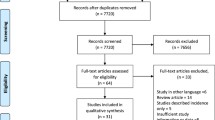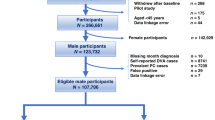Abstract
Objectives
Few studies discussed the link between benign prostatic hyperplasia (BPH) and bladder cancer. We performed this cohort study to investigate whether there is an association between BPH and subsequent risk of bladder cancer.
Methods
We identified 35,092 study subjects including 17546 BPH patients and 17546 comparisons from the National Health Insurance database. The comparison cohort was frequency matched with age and index-year. We measured subsequent bladder cancer rates (per 1000 person-years) in two cohorts. Attributable risks (ARs) was calculated based on the bladder cancer rates in two cohorts. The hazard ratios (HRs) and 95% confidence intervals (CIs) for bladder cancer were estimated via Cox proportional hazard regression.
Results
BPH patients had a higher bladder cancer rate than comparisons (AR = 0.81 per 1000 person-years) and exhibited 4.69- and 4.11-fold increases in bladder cancer risk in the crude and adjusted Cox models, respectively (95% CIs = 4.15–6.99 and 2.70–6.26). The AR was highest in patients aged 65–74 years old (AR = 1.33). BPH patients with chronic kidney disease were at an elevated bladder cancer risk. Regarding the association between bladder cancer and transurethral prostatectomy (TURP), BPH patients who underwent TURP were at a higher risk of bladder cancer (AR = 1.69; HR = 6.17, 95% CI = 3.68–10.3) than those who did not (AR = 0.69; HR = 3.73, 95% CI = 2.43–5.74).
Conclusions
In this study, BPH patients were found to have an increased risk of subsequent bladder cancer. Based on the limitations of retrospective nature, further studies are needed.


Similar content being viewed by others
References
Auffenberg GB, Helfand BT, McVary KT (2009) Established medical therapy for benign prostatic hyperplasia. Urol Clin North Am 36:443–459
Barry MJ, Fowler FJ Jr, Bin L et al (1997) The natural history of patients with benign prostatic hyperplasia as diagnosed by North American urologists. J Urol 157:10–14
Fong YK, Milani S, Djavan B (2005) Natural history and clinical predictors of clinical progression in benign prostatic hyperplasia. Curr Opin Urol 15:35–38
Djavan B, Nickel JC, de la Rosette J et al (2002) The urologist view of BPH progression: results of an international survey. Eur Urol 41(5):490–496
Sarma AV, Wei JT (2012) Clinical practice. Benign prostatic hyperplasia and lower urinary tract symptoms. N Engl J Med 367(3):248–257
Matsumoto S, Shimizu N, Hanai T, Uemura H, Levin R (2009) Bladder outlet obstruction accelerates bladder carcinogenesis. BJU Int 103:1436–1439
Hecht SS (2002) Human urinary carcinogen metabolites: biomarkers for investigating tobacco and cancer. Carcinogenesis 23(6):907–922
Mommsen S, Sell A (1983) Prostatic hypertrophy and venereal disease as possible risk factors in the development of bladder cancer. Urol Res 11(2):49–52
Nakata S, Sato J, Ohtake N et al (1995) Epidemiological study of risk factors for bladder cancer. Hinyokika Kiyo 41(12):969–977
Greenwald P, Kirmss V, Polan A et al (1974) Cancer of the prostate among men with benign prostatic hyperplasia. J Natl Cancer Inst 53:335–340
Kang D, Chokkalingam AP, Gridley G et al (2007) Benign prostatic hyperplasia and subsequent risk of bladder cancer. Br J Cancer 96(9):1475–1479
Tseng CH (2013) Benign prostatic hyperplasia is a significant risk factor for bladder cancer in diabetic patients: a population-based cohort study using the National Health Insurance in Taiwan. BMC Cancer 13:7
Dai X, Fang X, Ma Y et al (2016) Benign prostatic hyperplasia and the risk of prostate cancer and bladder cancer: a meta-analysis of observational studies. Medicine (Baltim) 95(18):e3493
Lin YC, Liang SJ, Liu YH, Hsu WH, Shih CM, Sung FC, Chen W (2012) Tuberculosis as a risk factor for systemic lupus erythematosus: results of a nationwide study in Taiwan. Rheumatol Int 32(6):1669–1673
Sung PS, Yeh CC, Wang LC, Hung PH, Muo CH, Sung FC, Chen CH, Tsai KJ (2017) Increased risk of dementia in patients with non-apnea sleep disorder. Curr Alzheimer Res 14(3):309–316
Kang JH, Keller JJ, Lin YK, Lin HC (2012) A population-based case-control study on the association between rheumatoid arthritis and deep vein thrombosis. J Vasc Surg 56(6):1642–1648
Tseng CH (2011) Diabetes and risk of bladder cancer: a study using the National Health Insurance database in Taiwan. Diabetologia 54(8):2009–2015
Lo SF, Chang SN, Muo CH, Chen SY, Liao FY, Dee SW, Chen PC, Sung FC (2013) Modest increase in risk of specific types of cancer types in type 2 diabetes mellitus patients. Int J Cancer 132(1):182–188
Freedman ND, Silverman DT, Hollenbeck AR, Schatzkin A, Abnet CC (2011) Association between smoking and risk of bladder cancer among men and women. JAMA 306(7):737–745
Burger M, Catto JW, Dalbagni G et al (2013) Epidemiology and risk factors of urothelial bladder cancer. Eur Urol 63(2):234–241
Walker NF, Gan C, Olsburgh J et al (2014) Diagnosis and management of intradiverticular bladder tumours. Nat Rev Urol 11(7):383–390
Michaud DS, Spiegelman D, Clinton SK et al (1999) Fluid intake and the risk of bladder cancer in men. N Engl J Med 340:1390–1397
Jiang X, Castelao JE, Groshen S et al (2008) Water intake and bladder cancer risk in Los Angeles County. Int J Cancer 123:1649–1656
Radosavljević V, Janković S, Marinković J et al (2003) Fluid intake and bladder cancer. A case control study. Neoplasma 50(3):234–238
Zhou J, Kelsey KT, Giovannucci E et al (2014) Fluid intake and risk of bladder cancer in the Nurses’ Health Studies. Int J Cancer 135(5):1229–1237
Altieri A, La Vecchia C, Negri E et al (2003) Fluid intake and risk of bladder and other cancers. Eur J Clin Nutr 57(Suppl 2):S59–S68
Zhou J, Smith S, Giovannucci E et al (2012) Reexamination of total fluid intake and bladder cancer in the health professionals follow-up study cohort. Am J Epidemiol 175(7):696–705
Shariat SF, Milowsky M, Droller MJ (2009) Bladder cancer in the elderly. Urol Oncol. 27(6):653–667
Taylor JA 3rd, Kuchel GA (2009) Bladder cancer in the elderly: clinical outcomes, basic mechanisms, and future research direction. Nat Clin Pract Urol 6(3):135–144
Serrano M, Blasco MA (2007) Cancer and ageing: convergent and divergent mechanisms. Nat Rev Mol Cell Biol 8:715–722
Toren Finkel T, Serrano M, Blasco MA (2007) The common biology of cancer and ageing. Nature 448:767–774
Lichtman SM et al (2007) Geriatric oncology: a field coming of age. J Clin Oncol 25:1821–1823
Lynch CF, Cohen MB (1995) Urinary system. Cancer 75:316–329
Perše M, Injac R, Erman A (2013) Oxidative status and lipofuscin accumulation in urothelial cells of bladder in aging mice. PLoS One. 8(3):e59638
Blagosklonny MV (2005) Carcinogenesis, cancer therapy and chemoprevention. Cell Death Differ 12(6):592–602
Shahriyari L, Komarova NL (2013) Symmetric vs. asymmetric stem cell divisions: an adaptation against cancer? PLoS One 8(10):e76195
Hou L, Zhang X, Wang D et al (2012) Environmental chemical exposures and human epigenetics. Int J Epidemiol 41(1):79–105
Wood GA, Korkola JE, Archer MC (2002) Tissue-specific resistance to cancer development in the rat: phenotypes of tumor-modifier genes. Carcinogenesis 23(1):1–9
Rassweiler J, Teber D, Kuntz R et al (2006) Complications of transurethral resection of the prostate (TURP)–incidence, management, and prevention. Eur Urol 50(5):969–979
Yamasaki T, Naganuma T, Iguchi T et al (2011) Association between chronic kidney disease and small residual urine volumes in patients with benign prostatic hyperplasia. Nephrology (Carlton) 16(3):335–339
Rule AD, Jacobson DJ, Roberts RO et al (2005) The association between benign prostatic hyperplasia and chronic kidney disease in community-dwelling men. Kidney Int 67(6):2376–2382
Chen CH, Shun CT, Huang KH, Huang CY, Yu HJ, Pu YS (2008) Characteristics of female non-muscle-invasive bladder cancer in Taiwan: association with upper tract urothelial carcinoma and end-stage renal disease. Urology. 71:1155–1160
Li CE, Chien CS, Chuang YC et al (2016) Chronic kidney disease as an important risk factor for tumor recurrences, progression and overall survival in primary non-muscle-invasive bladder cancer. Int Urol Nephrol. 48(6):993–999
Birkeland SA, Lokkegaard H, Storm HH (2000) Cancer risk in patients on dialysis and after renal transplantation. Lancet 355:1886–1887
Kasiske BL, Snyder JJ, Gilbertson DT, Wang C (2004) Cancer after kidney transplantation in the United States. Am J Transplant. 4:905–913
Acknowledgements
This study is supported in part by Taiwan Ministry of Health and Welfare Clinical Trial Center (MOHW106-TDU-B-212-113004), China Medical University. Hospital, Academia Sinica Taiwan Biobank Stroke Biosignature Project (BM10601010036), Taiwan Clinical Trial Consortium for Stroke (MOST 106-2321-B-039-005), Tseng-Lien Lin Foundation, Taichung, Taiwan, Taiwan Brain Disease Foundation, Taipei, Taiwan, and Katsuzo and Kiyo AoshimaMemorial Funds, Japan.
Author information
Authors and Affiliations
Contributions
CWF conceived and designed the study as well as wrote the initial draft of the manuscript. CHL participated in the study design and conception. CHM performed data analysis and interpretation and was involved in writing the initial draft of the manuscript. SCW designed the study, performed data analysis and interpretation and was involved in manuscript drafting and revision. Guarantor of the article: Wu SC, MD.
Corresponding author
Ethics declarations
Conflict of interest
This study used the National Health Insurance Research Database established by the National Health Research Institutes with the authorization of the Bureau of National Health Insurance of the Department of Health of Taiwan. The interpretations and conclusions contained herein do not represent the opinions of the aforementioned agencies and institutions. The authors declare that there are no conflicts of interest related to this study.
Research involving human participants and/or animals
To comply with the Personal Information Protection Act, all of the identifying information of the insured people were removed and replaced with surrogate numbers for research use. This study was approved by the Research Ethics Committee of China Medical University and Hospital in Taiwan [CMUH104-REC2-115(CR-1)].
Informed consent
Not applicable.
Rights and permissions
About this article
Cite this article
Fang, CW., Liao, CH., Wu, SC. et al. Association of benign prostatic hyperplasia and subsequent risk of bladder cancer: an Asian population cohort study. World J Urol 36, 931–938 (2018). https://doi.org/10.1007/s00345-018-2216-8
Received:
Accepted:
Published:
Issue Date:
DOI: https://doi.org/10.1007/s00345-018-2216-8




